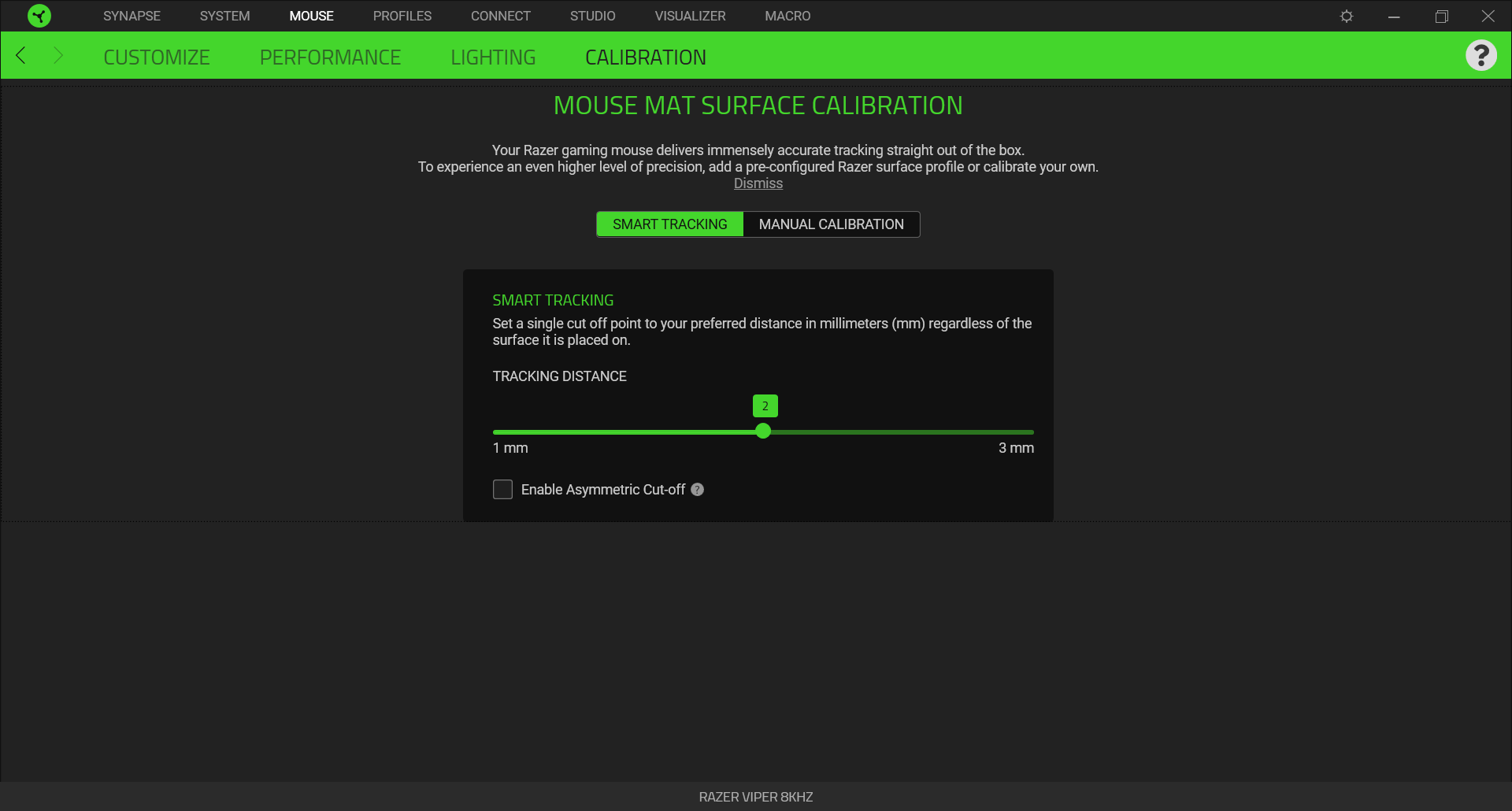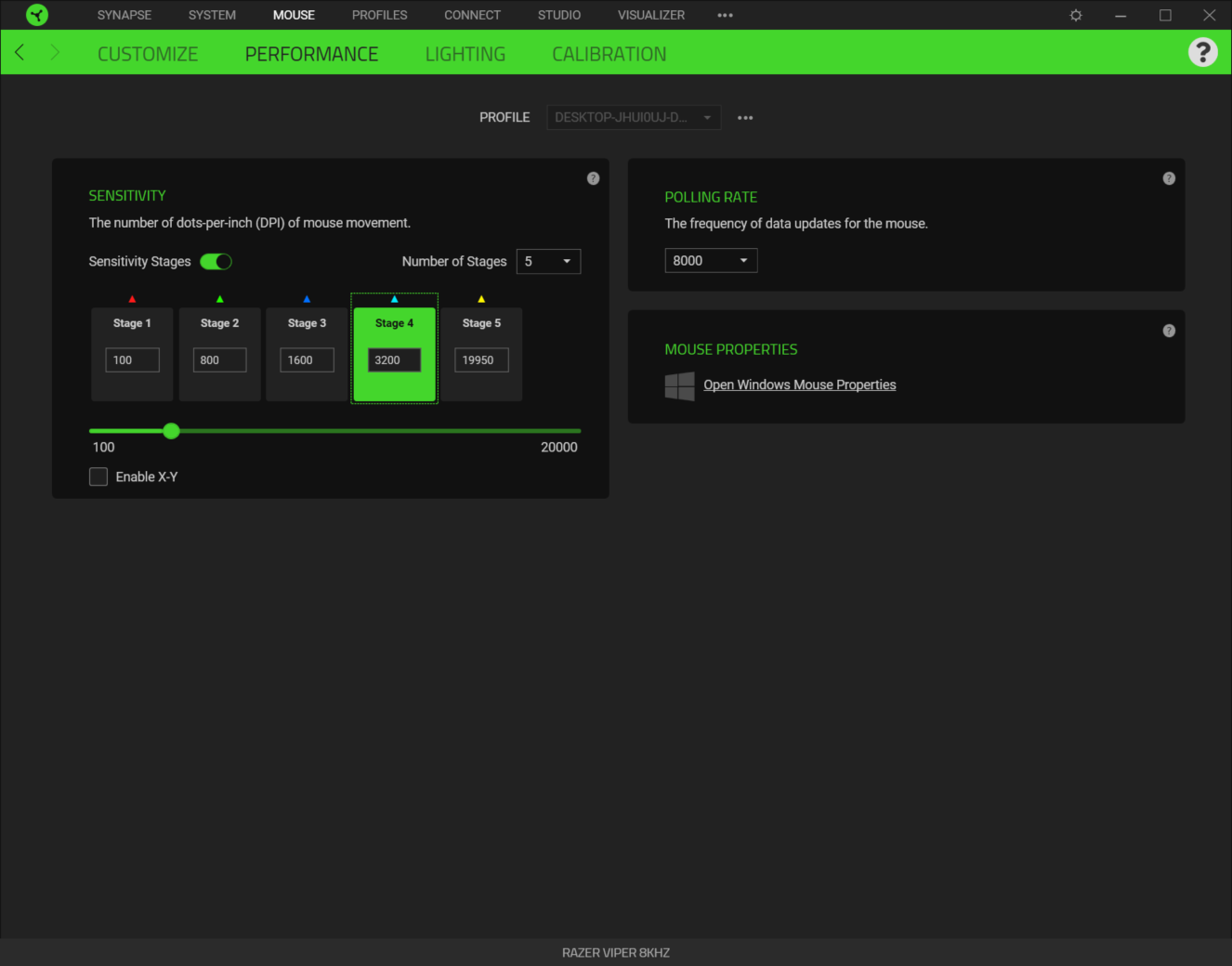Tom's Hardware Verdict
The Razer Viper 8K Hz shows what an 8,000 Hz polling rate can do to improve the tracking of fast mouse movements if you have a powerful enough setup. But the Razer Viper series has its own design flaws, like some inconveniently placed side buttons.
Pros
- +
Mouse movements can look smoother on screen
- +
Ambidextrous
- +
Many programmable buttons
- +
No 8,000 Hz price premium
Cons
- -
High polling rate can be inconsistent
- -
Adaptive-Sync should be turned off
- -
Half of the 4 side buttons are hard to use
- -
Not great for palm grips
Why you can trust Tom's Hardware
Which spec is most important for making the best gaming mouse -- one that could be used by the pros? If you've been looking at new mouse specs lately, you might suspect it’s sensitivity. Many gaming mice have been upping max sensitivity to the point where 20,000 counts per inch (CPI) isn’t uncommon. We’ve long argued, however, that the perceived gains can be minimal and that we’ve basically been in a CPI chase that many gamers, still comfortable in the 3,000-CPI range, tend to ignore.
The Razer Viper 8K Hz is after a different kind of high. Its hallmark feature is an 8,000 Hz polling rate that trumps the 1,000 Hz rate most mice today carry. While most mice send reports to its connected PC 1,000 times a second, the Viper 8K Hz does it 8,000 times a second. Available for $80, the same price as the original Razer Viper with a 1,000 Hz polling rate and lesser sensor specs, the mouse is an easy buy for those seeking an ambidextrous mouse with extreme performance. But how big of an impact will an 8,000 Hz polling rate have on your skills? That depends on how skilled you are and if you’ve ever blamed a misfire on poor mouse tracking.
Razer Viper 8K Hz Specs
| Sensor Model | Razer Focus+ |
| Sensitivity | 20,000 CPI |
| Polling Rate | 8,000 Hz |
| Programmable Buttons | 9, including 3 scroll wheel functions |
| LED Zones and Colors | 1x RGB |
| Cable Length | 6 feet (1.8m) |
| Measurements (LxWxH) | 4.99 x 2.27 x 1.49 inches (126.73 x 57.60 x 37.81mm |
| Weight | 2.50 ounces (71g) |
8,000 Hz Polling Rate
Most mice offer a 1,000 Hz polling rate, and you’ve probably never noticed a problem with that. A 1,000 Hz polling rate means the mouse can send a report to your PC telling the machine of the mouse’s position as many as 1,000 times every second. The Viper 8K Hz bumps that to 8,000 reports per second.
A 1,000 Hz polling rate also equates to a 1ms minimum delay, meaning it should typically take as little as 1ms for the mouse to send each report. Here’s the math: If a mouse is sending 1,000 reports a second, each report takes 0.001 seconds (1 second divided by 1,000 reports equals 0.001 second per report), aka 1ms, to send. The Viper 8K Hz drops that minimum to 0.125ms (1 second divided by 8,000 reports equals .000125 second, or 0.125ms).
The Viper 8K Hz accomplishes this with a high-speed USB microcontroller. Of course, Razer had to give this tech its own brand name, and the gaming company went with HyperPolling (matching its other Hyper-based tech, like HyperSpeed). Razer looks like the first with a widely available 8,000 Hz mouse. There’s the AtomPalm Hydrogen, but that doesn’t seem to be shipping yet.
Razer sees the increased polling rate as bringing a greater advantage in gaming, specifically around improving aim and synced-up shots. And that advantage is perceived as being greater than what a higher CPI spec provides, which Razer admits may not yield usable advantages.
“Unlike the usual chase for higher DPI, we believe in giving gamers an actual advantage.
Get Tom's Hardware's best news and in-depth reviews, straight to your inbox.
If it truly had any practical applications in gaming, then the highest DPI settings would be used by every eSports player,” Razer boldly states in its reviewer’s guide. Instead, the vendor thinks the combination of the Viper 8K Hz’s sensor, plus fast switches and polling rate will yield desired gameplay.
With faster and consistent polling rate, the goal is faster, smoother clicks and no mouse microstuttering, or the mouse looking like it’s slightly jumped instead of flowing around smoothly. This also comes with a drop in system latency, the amount of time from when you move or click your mouse to when you see that happen on your screen. Razer thinks this will help with aim, because the gamer’s PC is getting more frequent, up-to-date reports on where the mouse is.
But why now? Well, in October, when I tried Razer’s 8,000 Hz prototype, Razer told me it sees 8,000 Hz as a necessary improvement as monitors continue climbing to higher refresh rates. We’ve tested many of the best gaming laptops with 300 Hz screens, and two of the best gaming monitors, (the Asus ROG Swift PG259QN and Alienware AW2521H) can hit 360 Hz.
Razer isn’t alone in this mindset. BlurBusters has pointed to microstutters becoming more prominent as refresh rates increase. In this 2020 example, the site compared 125 Hz to 500 Hz and beyond, which is past where we are today, and argued that faster refresh rates, (as well as higher resolutions, wider fields of view, larger screens and brighter HDR), “all simultaneously combine to lower the noise floor, to make [even] tinier flaws more human visible.”
So, Razer is promising a very responsive mouse with unprecedented tracking abilities and latency. But how well a mouse performs during actual gameplay also largely depends on how easy it is to move and manipulate the mouse at your will. This has a lot to do with the mouse’s design.
Design and Comfort
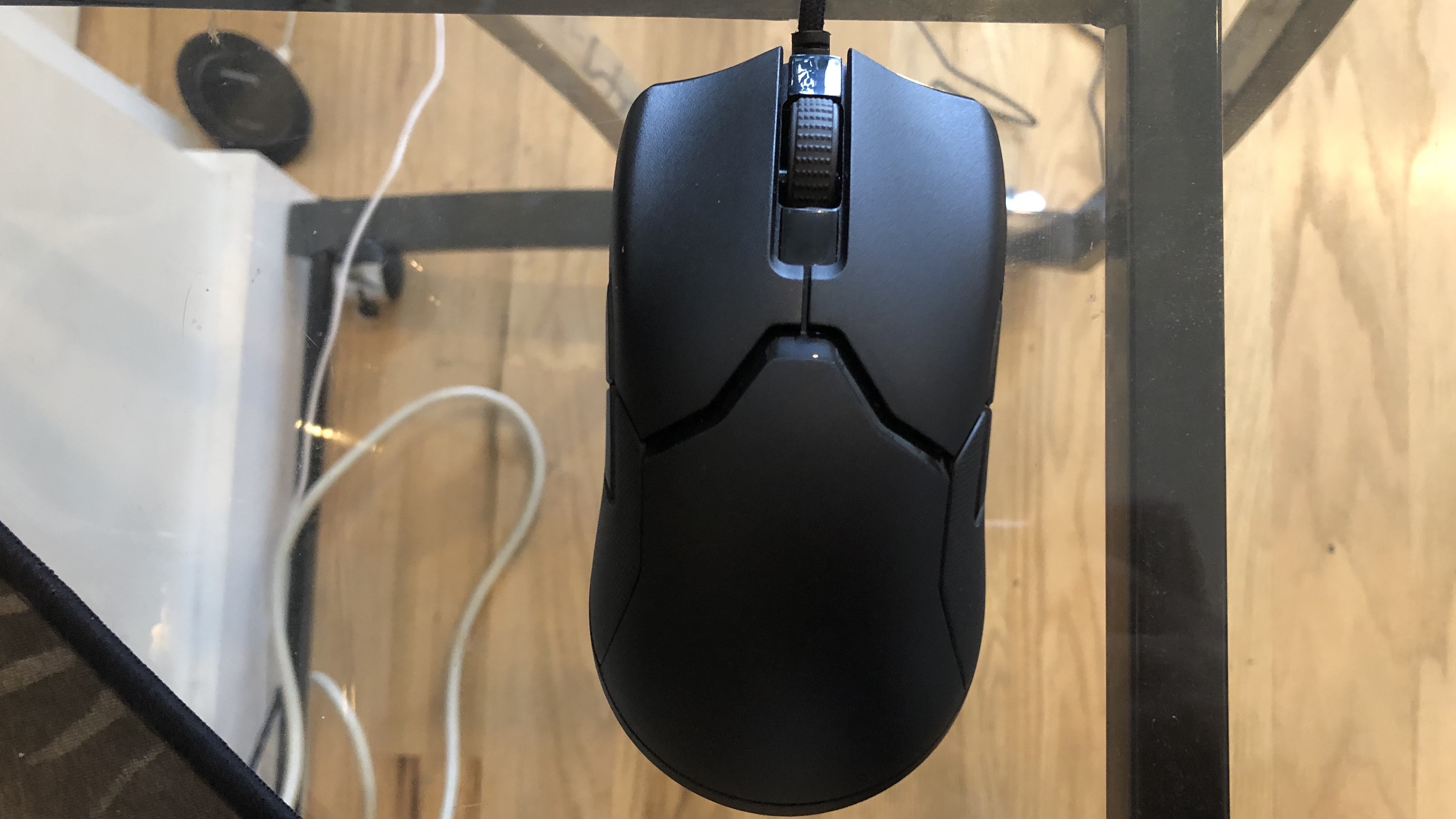
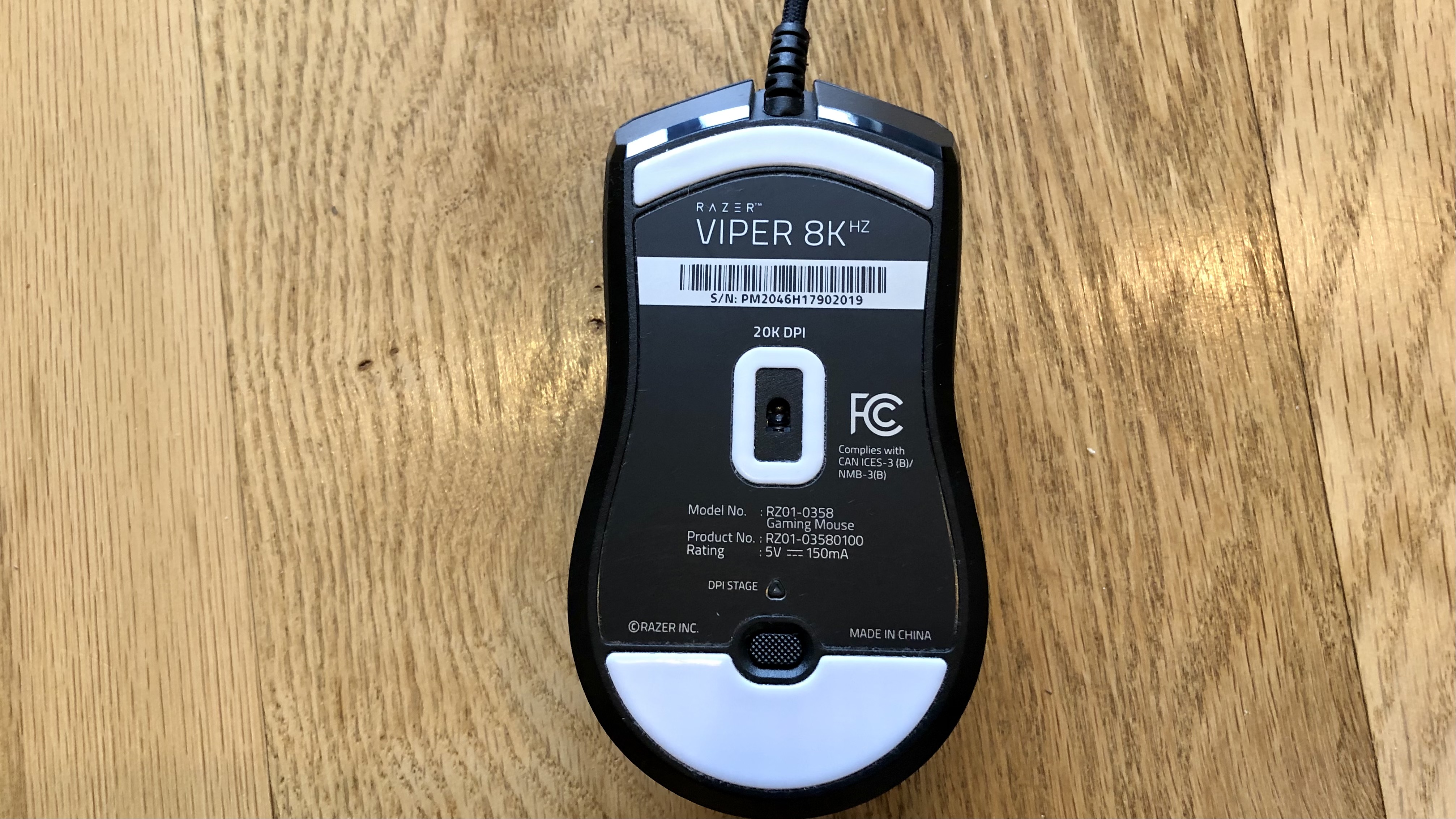
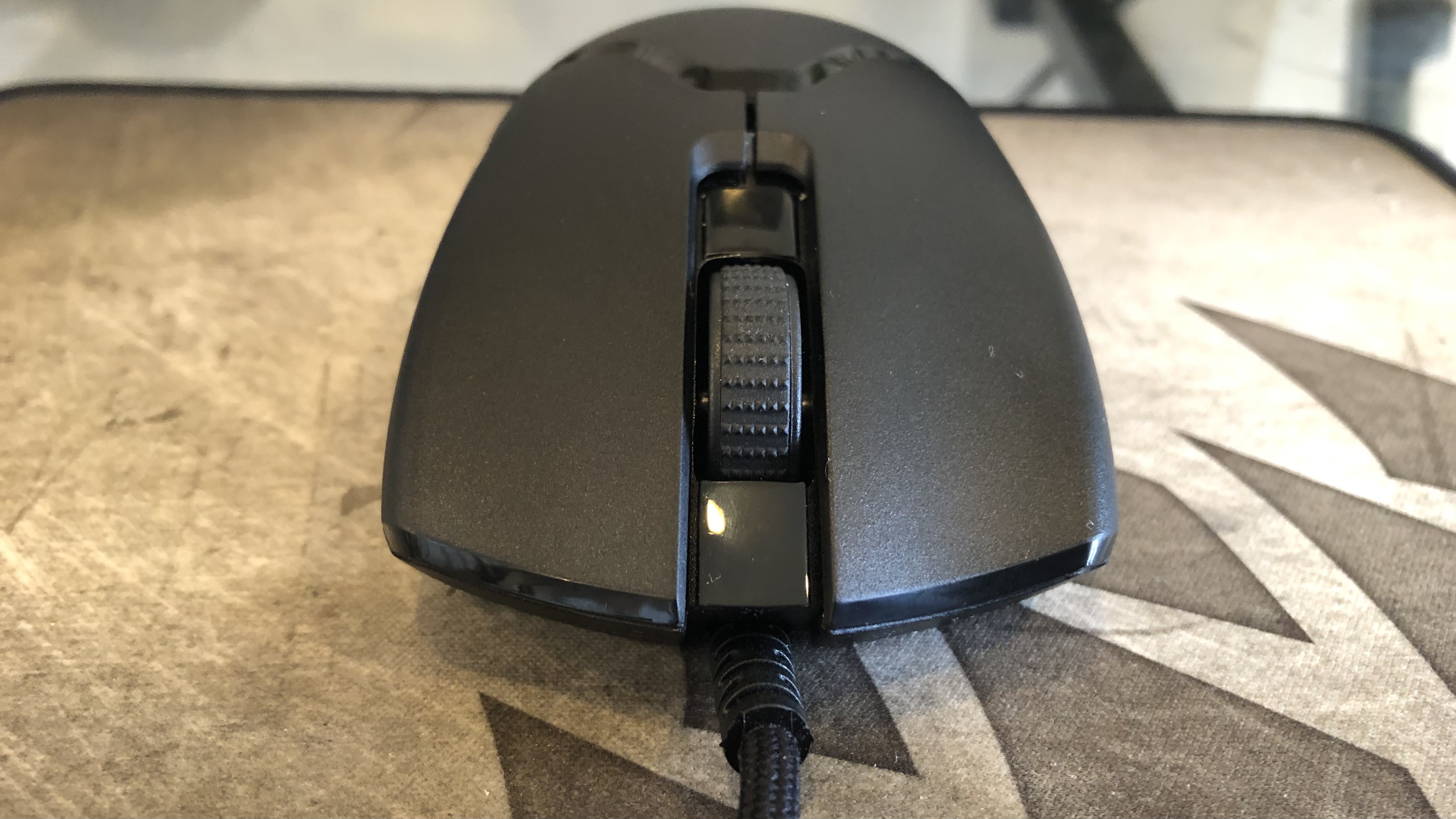

The Viper 8K Hz carries the same shape as the original Razer Viper and, therefore, the wireless Razer Viper Ultimate. All three mice measure 4.99 x 2.27 x 1.49 inches; however, the Viper 8K Hz is a little heavier than the original Viper (2.50 versus 2.43 ounces). That’s because Razer had to make the cable slightly thicker in order to accommodate the 8,000 Hz polling rate. The cable -- which is Razer Speedflex, a braided cloth -- still resists drag plenty well but feels slightly firmer than the Razer DeathAdder V2 Mini’s in a direct comparison.
2.50 ounces is still pretty lightweight though. It’s not quite as light as most honeycomb mice (the Glorious Model D, for example, is 2.40 ounces for the matte version) but still lighter than the MSI Clutch GM30 (3.46 ounces) or Razer DeathAdder Elite (3.70 ounces).
As such, the Viper 8K Hz is decently easy to move around for its weight, and the 100% PTFE feet on the bottom help. They provide a noticeable amount of extra glide, making the mouse as easy to control as the lighter (2.40 ounces) Roccat Burst Pro, but not more effortless to control than the super small and lightweight (2.24 ounces) Razer DeathAdder V2 Mini.
Like other Vipers, this speedier take is ambidextrous. The symmetrical shape will cater to both left or right hands, and there are even two buttons on each side. However, half of those side buttons will likely go unused. As a righty, it’s nearly impossible to hit any of the buttons on the right side without having to hold my hand oddly and uncomfortably. The Viper series favors fingertip and claw grippers, and with my claw grip I never accidentally hit the right-flanked side buttons, but those with larger hands might. With its 1.49-inch height that peaks closer to the center of the mouse’s body than I’d prefer, the Viper 8K Hz Hz doesn’t provide enough of a hump for a comfortable palm grip, especially if you have a bigger hand.
The Viper 8K Hz has 7 programmable buttons in total. In addition to the four side buttons, there’s the right click, scroll wheel up, down and in and CPI switch on the underside. The CPI switch’s location will require extra work, slowing on-the-fly adjustments. But with the extra buttons, that function’s easily reprogrammable. Additionally, the design prevents accidental CPI changes, and the smooth gap south of the scroll wheel is a comfortable place to rest your middle finger in between action.
My favorite part of the Viper 8K Hz’s build is the hard injection-molded side grips. They’re part of the mouse’s chassis, so they won’t fall off. but, they could eventually degrade, and it’s easy for dust to accumulate between the grooves. The grips are so hard and well-incorporated into the mouse that you’d be surprised they’re rubber. The fine texturing provides a comfortable grip that feels a little more slick than some grips, such as what Razer Mouse Grip Tape offers, but refreshingly natural.
Razer opted for a tactile scroll wheel, with a firm click that sounds more hollow and less clicky than other gaming mice’s wheels. It’s also rubber, with rows of hard, small bumps, but if you look very closely you can tell it’s not injection molded like the other rubber on the mouse.
RGB is limited to a single zone which, of course, goes to the Razer logo. This is programmable via software (more on that below) but will usually be covered when using the mouse.
Minimum Recommended Specs
Does Razer put its hertz where its mouth is? Before we could find out, we had to meet the Viper 8K Hz’s minimum requirements. Yes, this mouse has its own recommended specs.
In order to reap the maximum benefits out of the 8,000 Hz mouse, Razer recommends you have at least the following:
- CPU: Intel Core i5-8600K or AMD R5 3600
- GPU: Nvidia GTX 1080 or AMD RX 5700
- Display: 144 Hz refresh rate, Adaptive-Sync (Nvidia G-Sync or AMD FreeSync) off
The forced removal of Adaptive-Sync is odd, especially since the screen tear-fighting feature goes hand-in-hand with high-performance gaming. A Razer representative told me that the assumption here is that the PC is strong enough to run the game at well over the monitor's refresh rate. Adaptive-Sync limits the frame rate of the game to the screen’s max refresh rate. If the game is running at an unlocked frame rate, “the benefits of a high-speed mouse are a lot more apparent because the game is able to make use of the high-speed reporting of the mouse to a much greater degree, and the high-speed reporting of the mouse ‘smoothes out’ any desync caused due to frame time variation.”
The 144 Hz requirement is more attainable, but Razer claims that the higher the refresh rate, the greater the benefits. This is a future-proofing mouse, and it’s best mate currently is, really, a 360 Hz monitor, which we’ve found to show noticeable improvements in speed and response compared to 240 Hz monitors. I didn’t have one on hand though, so for my testing I used a Razer Blade 15 Advanced Model, one of the best gaming laptops.
- CPU: Intel Core i7-10875H
- GPU: Nvidia RTX 2070 Super Max-Q (8GB GDDR6)
- RAM: 16GB DDR4-2933
- Display: 300 Hz, 1920 x 1080 resolution (Adaptive-Sync not available)
Of course, when it comes to input lag there are other factors at work besides the mouse's individual latency. The overall amount of time it takes for my mouse input to appear on screen not only depends on the mouse, but also how long my CPU and GPU take to process it, as well as the screen. I have decent specs here, but the lowest latency results possible would require something like a desktop RTX 3090, along with a 360 Hz monitor.
For testing, I also set the laptop to use its discrete GPU only and put the CPU and GPU on boost modes in the laptop’s Synapse software to further fight latency.
8,000 Hz Polling Rate Testing
Before we get started, it should be noted that these comparisons should be taken with a grain of salt. The most accurate way to compare mouse polling rates would be to use some sort of machine that could move the mice at equal and consistent speeds and motions. Instead, I have to use my flawed human arm, but this is also a more realistic portrayal of how humans use a mouse.
Additionally, as pointed out earlier, these mice can only be swiped and clicked as quickly as their designs allow. A mouse with poor switches, for example, could be harder to press and result in slower response times.
The Viper 8K Hz is specced for up to 20,000 CPI, a max velocity of 650 inches per second (IPS) and max acceleration of 50g. For comparison, we brought in two 1,000 Hz mice:
- Razer DeathAdder V2 Mini (2.24 ounces, up to 8,500 CPI sensitivity, 350 IPS, 35g)
- Roccat Burst Pro (2.40 ounces, up to 16,000 CPI, 400 IPS, 50g)
I set each mouse to a comfortable CPI setting for my taste: 3,200.
First, I tried making large, quick ovals with the mice to see if I could immediately see any obvious differences. This made it look like there was a trail of cursors forming ovals. I watched the trail of cursors closely, and with both the DeathAdder V2 Mini and Burst Pro, it looked like there were many arrows very close to each other on the left and right sides. But when it came to the top and bottom sides of the oval, the arrows were much more spread out, about 1 inch between each pointer.
When I did this same action with the Viper 8K Hz, the points of the oval where I could see arrows seemingly shoulder-to-shoulder expanded. It still mostly occurred on the left and right sides but was starting to appear more into the top and bottom sides. 8,000 Hz was ultimately enabling my screen to show me more frequent updates of my pointer’s location.
I also tried moving each mouse back forth as fast as possible across a 1-1.5-inch area. With the DeathAdder V2 Mini and Burst Pro, I could see two gaps between the arrow trail. But when I made the same moves with the Viper 8K Hz, gaps weren’t apparent.
To test that the Viper 8K Hz is indeed operating at 8,000 Hz and doing so consistently, I turned to BenQ’s Mouse Rate Checker. This is an online tool, so the web may introduce some lag. However, I was able to hit an average polling rate of 5857.73 Hz. The highest polling rate I saw was 6,944 Hz, and the lowest was 5,040 Hz. With the DeathAdder V2 Mini, I averaged 952.90 Hz, with the highest polling rate being 1,012 Hz and the lowest 632 Hz. And with Roccat’s Burst Pro, I averaged 980.90 Hz, maxing at 1016 Hz and dropping as low as 660 Hz. With all the mice, it was easier to get higher polling rates when attempting to make circles quickly, rather than straight lines.
Razer also sent over its own polling rate testing app, which doesn’t require the internet. Here, it was easier to reach each mouse’s max polling rate and more consistently, especially if I, again, made circles. In this way, I was able to see consistent 1,000 Hz rates with the DeathAdder V2 Mini and Burst Pro. But I wasn’t able to achieve the same thing with the Viper 8K Hz. While making the same motions as I did with the other test mice (to the best of my ability), the Viper 8K Hz’s polling rate was usually in the 7,800s but never a steady 8,000.
To see if the higher polling rate helped my reaction time, I tried the Human Benchmark reaction time test, which has you click the mouse as soon as the screen turns from red to green. After a few trial runs to get used to it, I went through multiple tests with each mouse. I got my best time, 142ms, with the Viper 8K Hz, where I averaged 149.6ms. My best time with the DeathAdder V2 Mini was 152ms, and my average was 155.8ms. And with the Burst Pro, my best time was 157ms with a 163.4ms average. Since this test is about fast clicks, button feel and switches are certainly factors, and the Burst Pro’s bulkier buttons likely hindered me.
VSyncTester’s HTML/JavaScript mouse input performance benchmark looks at mouse latency. Again, this test is subject to how consistently I can move each mouse, but the Viper 8K Hz managed the best score, usually in the 3.30ms range. The DeathAdder V2 Mini and Burst Pro were both typically in the 3.40ms area, not far behind.
I had no issues using Windows with the mouse set to 8,000 Hz. But Razer’s Synapse software also lets you bring down the polling rate to 125, 500, 1,000, 2,000 or 4,000 Hz. That many options is probably overkill, but it can be fun to experiment. Some older Windows apps and games could result in finicky behavior with higher polling rates. Razer told me that most games should work with 8,000 Hz if you have a “strong enough PC” but certain games might require optimization. Razer said it’s already working with game studios on this.
Gaming Performance
Polling rate isn’t the only thing boosted on the Viper 8K Hz. Even if you ignore the high polling rate, this is a high-specced rat, thanks to Razer’s homegrown Focus+ optical sensor. Although in introducing this mouse Razer is saying demonstratively and literally that it thinks a high polling rate enhances the gaming experience more than high CPI, the Viper 8K Hz still goes up to 20,000 CPI. The sensor is also specced to handle velocities of up to 650 IPS and 50g of acceleration. That’s an upgrade from the original Viper, which uses the Razer 5G optical sensor (16,000 CPI / 450 IPS / 50g) but matches the pricier wireless Viper Ultimate’s specs. But unless you game at the highest CPI (most don’t) or move your mouse with super aggression, you probably would’ve been fine with the 5G.
Overall, the gaming experience with the Viper 8K Hz was smooth and responsive. In Overwatch, I turned the settings down to low and hit frame rates of up to 339 frames per second (fps) during times of low movement, but the game was typically in the 240s during normal action and dropped to around 212 fps during intense action.
Could I immediately notice that the mouse was sending reports to my PC quicker during live action? No. Personally, the effect was more noticeable during carefully scrutinized tests like above, not during focused gameplay. If you’re a very serious gamer with a very trained eye, you’ll likely notice the difference though -- just like I noticed the difference in cursor trails in the testing above. Obviously, there’s a lot more for your eyes to keep track of during an actual game. The effect of moving to 8,000 Hz will likely be subtle for mainstream or casual gamers, but a serious or more pro-level gamer may be able to tell.
All of Razer’s Viper mice use optical mechanical switches in the left and right buttons. These switches operate when the stem goes through a light beam instead of via metallic contact, like regular mechanical switches. Optical switches are also supposed to be resistant to debouncing and the accidental double-clicking that happens with some mice’s mechanical switches after heavy use over time. All the Razer Viper mice use Razer’s optical mechanical mouse switches, but the Viper 8K Hz moves to the second generation of these switches, which are supposed to be more tactile.
In a side-by-side comparison with the Razer DeathAdder V2 Mini, which uses the first-gen optical clicky switches, the Viper 8K Hz’s button felt more solid to click, while the DeathAdder V2 Mini’s felt lighter to depress. I’ve felt snappier clicks before though, and the subtle weight of the Viper 8K Hz’s can be more tiring. For very fast, repetitive clicking, I’d actually opt for the DeathAdder V2 Mini because it feels less exhausting to depress.
And compared to the Roccat Burst Pro, which uses Roccat’s tactile optical switch (think of these like bespoke optical brown switches and the Viper 8K Hz’s like homemade optical blues), the Viper 8K Hz was easier to depress. The buttons are less heavy and their sound less clicky.
Features and Software
In addition to beefier specs, the Focus+ also has some high-end features. But to be honest, there’s a good chance you’ll never notice them.
Motion Sync is supposed to improve sensor responsiveness for better tracking (similarly to the boosted polling rate) “by syncing its signals at the exact intervals your PC extracts information,” according to Razer. In Synapse you can enable Asymmetric cut-off on the Focus+ sensor (it’s off by default). This lets you set the lift-off distance and landing distance, the point at which the mouse starts tracking again. The point is to keep it as low as possible to prevent cursor drift when your mouse touches down.
Smart tracking, meanwhile, lets you calibrate your mouse pad for consistent accuracy and lift-off. Razer’s Synapse software comes preloaded with calibration for numerous Razer-branded mouse pads; however, I had issues trying to manually calibrate the mouse with a Corsair mouse pad.
In addition to being able to select the polling rate and sensor features, Synapse lets you program all of the mouse’s buttons except for the left click (you can program the left click button if you assign the left click function elsewhere). If you assign one of the buttons as HyperShift, you can set a secondary function for the remaining programmable buttons. That’s a lot of potential inputs, including launching programs and macros, but also a reminder of how hard it is to access half the mouse’s side buttons.
Synapse’s Performance menu lets you set the CPI stages that the button on the mouse’s underside toggles through. You can set 2, 3, 4 or 5 CPI settings, adjustable by increments of 50. There’s a light indicator by the CPI switch helpfully reminding you which setting you’re at, and if you have Synapse, a large pop-up will also appear on the screen.
Synapse also lets you set up to 5 profiles on the mouse’s onboard memory, meaning you won’t have to download Synapse to carry 5 different sets of settings over to another PC. Sadly, one of those profiles automatically stores the last used profile on your mouse, (which you can ensure is a distinct, 5th profile if you pay attention), and RGB preferences don't carry over.
If you do use Synapse, you can store an limited number of profiles, including with RGB settings, usable with the software open, and every profile will be able to launch automatically with specific games or other apps.
RGB is limited, but you can control brightness, pick between Spectrum Cycling, Breathing, Reactive, Static or Audio Meter Effects. You can also create your own effects in Chroma Studio and have RGB sync with other Razer Chroma RGB-enabled products.
Bottom Line
So here we are with yet another extreme spec that will force gamers to decide if they really need the boost. The Razer Viper 8K Hz is a successful implementation of an 8,000 Hz polling rate, but you’ll need a high-end rig and one of the fastest gaming monitors to get the most out of the mouse. That includes a beefy graphics card, which is especially important since it’s recommended you don’t use G-Sync or FreeSync with the mouse.
With 8,000 Hz, I saw an improvement in my 300 Hz screen’s ability to show me the location of my mouse. Input lag tested slightly lower than 1,000-Hz mice, and my reaction time seemingly increased by a few milliseconds. How much you’ll notice this when gaming will depend on your skill level and how sharp your eye is.
But this isn’t a review of 8,000 Hz polling rates; it’s a review of the Viper 8K Hz specifically. And like the Razer Viper, Razer Viper Mini and wireless Razer Viper Ultimate, the design has its flaws. Although it’s ambidextrous, half of the side buttons are hard to use. It’s not great for large hands or palm grips, and the clicks could feel light and quicker.
Razer has made it so that there’s no point in buying the original Viper if given the choice. The Viper 8K Hz has a more advanced sensor and polling rate for the same $80 MSRP. Speaking of, it’s nice to see Razer inch away from focusing on high CPI, but also confusing because it’s been a strong participant in the CPI trend and even upped the CPI spec on the Viper 8K Hz over the original Viper.
The Viper 8K Hz has an audience, but it’s a specific one. If you’ve ever questioned whether your mouse was moving in sync with your arm, you’re on the list. If you swear by 360 Hz and the highest frame rates/lowest lag possible, you’ve just gone to the top of the list.
For those who have the eyes, skillset and gear to actually reap the benefits of 8,000 Hz, the Viper 8K Hz is one of a kind and a glimpse into the future.

Scharon Harding has over a decade of experience reporting on technology with a special affinity for gaming peripherals (especially monitors), laptops, and virtual reality. Previously, she covered business technology, including hardware, software, cyber security, cloud, and other IT happenings, at Channelnomics, with bylines at CRN UK.
-
RedCat888 (HIGUYS9090) In the end of the first paragraph under 8000 Hz polling rate testing there is humnans written.Reply
I actually just got my Viper mini 2 weeks ago, because I don't really need a normal viper, and I won't be able to use a 8000 Hz polling rate as I'm on a 4570 with integrated graphics using a 60 Hz monitor, so I don't regret it. -
Friesiansam This is just marketing twaddle from Razer. When even those gaming monitors with the least input lag, based on test figures from TFTCentral, still exhibit around 3 milliseconds lag compared to a CRT, no-one is going to see any real perceivable benefit from 8KHz polling.Reply -
nfineon LOL, law of diminishing returns means nothing to the marketing department! This is beyond imperceptible, 1000 times per second polling rate versus 8000? That's the difference between:Reply
.001 seconds to .000125 seconds.
the human brain can't come close to comprehending that difference. -
Findecanor ReplyA 1,000 Hz polling rate means the mouse can send a report to your PC telling the machine of the mouse’s position as many as 1,000 times every second.
A mouse does not report its position. It reports its relative movement.
Because the standard USB protocol for mice uses movements relative to the previous report and USB device hardware often is queue-oriented, there can be added latency of up to a polling-cycle. It depends on the hardware and firmware in the mouse.


